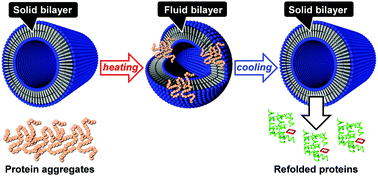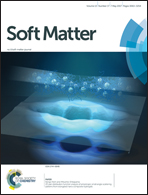Glycolipid-based nanostructures with thermal-phase transition behavior functioning as solubilizers and refolding accelerators for protein aggregates†
Abstract
The self-assembly of synthetic glycolipids produced nanostructures such as vesicles and nanotubes consisting of bilayer membranes, which underwent a gel-to-liquid crystalline thermal phase transition. Vesicles formed at temperatures above the thermal phase transition temperatures (Tg–l) could solubilize aggregates of denatured proteins by trapping them in the fluid bilayer membranes. Cooling to temperatures below Tg–l caused a morphological transformation into nanotubes that accompanied the thermal phase transition from the fluid to the solid state. This phenomenon allowed the trapped proteins to be quickly released into the bulk solution and simultaneously facilitated the refolding of the proteins. The refolding efficiency strongly depended on the electrostatic attraction between the bilayer membranes of the nanostructures and the proteins. Because of the long shape (>400 nm) of the nanotubes, simple membrane filtration through a pore size of 200 nm led to complete separation and recovery of the refolded proteins (3–9 nm sizes).



 Please wait while we load your content...
Please wait while we load your content...